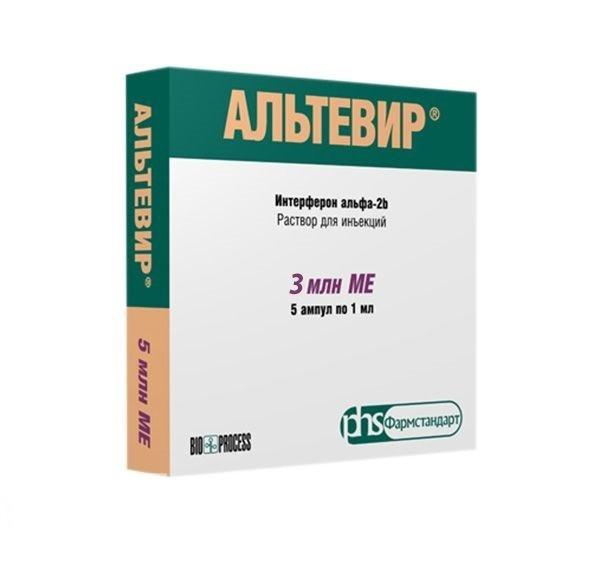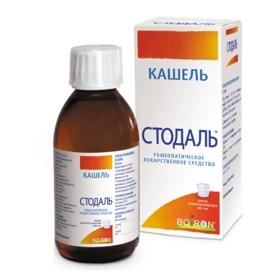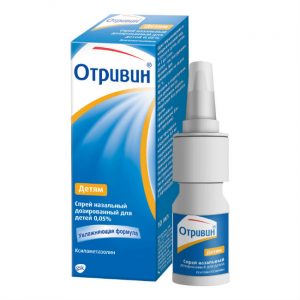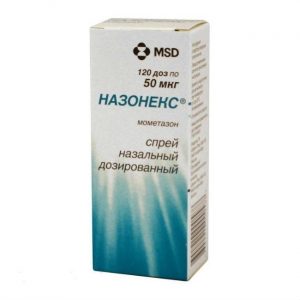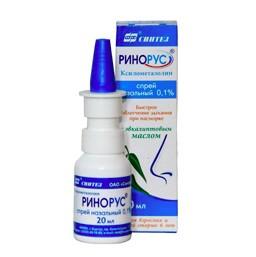Description
Release form
Injection.
Packing
5 ampoules of 1 ml.
Pharmacological action of
Altevir has antiviral, immunomodulating, antiproliferative and antitumor effects. Interferon alfa-2b, interacting with specific receptors on the cell surface, it initiates a complex chain of changes within the cell, including the induction of the synthesis of a number of specific cytokines and enzymes, disrupts the synthesis of viral RNA and virus proteins in the cell. The result of these changes is nonspecific antiviral and antiproliferative activity associated with the prevention of virus replication in the cell, inhibition of cell proliferation and the immunomodulatory effect of interferon. Interferon alpha-2b stimulates the process of antigen presentation to immunocompetent cells, has the ability to stimulate the phagocytic activity of macrophages, as well as the cytotoxic activity of T cells and natural killers involved in antiviral immunity. It prevents the proliferation of cells, especially tumor cells. It has a depressing effect on the synthesis of certain oncogenes, leading to inhibition of tumor growth.
Indications
Altevir is used in complex therapy in adults: in case of chronic viral hepatitis B without signs of liver cirrhosis,
in case of chronic viral hepatitis C in the absence of signs of liver failure (monotherapy or combination therapy with ribavirin),
in case of papillomatosis, condylomatosis
for hairy cell leukemia, chronic myelogenous leukemia, non-Hodgkin s lymphoma, melanoma, multiple myeloma, Kaposi s sarcoma with AIDS, progressive kidney cancer.
Contraindications
Hypersensitivity to recombinant interferon alfa-2b or any of the components of the drug, history of severe cardiovascular disease (uncontrolled heart failure, recent myocardial infarction, severe cardiac arrhythmias), severe renal and / or renal. including caused by the presence of metastases), epilepsy, and other severe disorders of the central nervous system, especially expressed by depression, suicidal thoughts and attempts (including a history), chronic hepatitis with decompensation Rowan and cirrhosis in patients receiving or recently received immunosuppressive therapy drugs (apart from the completed brief treatment GCS), autoimmune hepatitis, or other autoimmune disease as well as receiving immunosuppressive drugs following transplantation, thyroid disease that can not be controlled by conventional therapeutic methods. Decompensated lung diseases (including COPD), decompensated diabetes mellitus, hypercoagulation (including thrombophlebitis, pulmonary thromboembolism), severe myelosuppression, pregnancy, lactation.
Special instructions
Before treatment with chronic viral hepatitis B and C by Altevir, a liver biopsy is recommended to evaluate the degree of liver damage (signs of an active inflammatory process and / or fibrosis). The effectiveness of treatment for chronic hepatitis C increases with combination therapy with Altevir and ribavirin. The use of Altevir is not effective in the development of decompensated cirrhosis of the liver or hepatic coma.
In case of side effects during treatment with Altevir, the dose should be reduced by 50% or the drug should be temporarily discontinued until they disappear. If side effects persist or occur again after a dose reduction, or disease progression is observed, then treatment with Altevir should be discontinued.
With a decrease in platelet count below 50×109 / L or granulocyte level below 0.75×109 / L, a 2-fold reduction in the dose of Altevir is recommended with a blood test after 1 week. If these changes are saved, Altevir should be discarded.
With a decrease in platelet count below 25×109 / L or granulocyte level below 0.5×109 / L, it is recommended that Altevir be withdrawn with a blood test after 1 week.
In patients receiving interferon alfa-2b preparations, antibodies can be detected in the blood serum, antiviral activity neutralizing it. In almost all cases, antibody titers are low, their appearance does not lead to a decrease in the effectiveness of treatment or the occurrence of other autoimmune disorders.
Preparation of the solution for iv administration: the volume of the Altevir solution needed to prepare the required dose is collected, added to 100 ml of a sterile 0.9% NaCl solution and administered for 20 minutes.
Composition of
1 ml of solution contains: 3 million IU of interferon alfa-2b human recombinant
excipients: sodium acetate, sodium chloride, ethylenediaminetetraacetic acid disodium salt, tween 80, dextran 40, water for injection.
Dosage and administration of
Intramuscularly, s / c, iv, intrathecally, intraperitoneally, to the lesion site. Adults – a single dose – 3-6 million IU, if necessary, higher doses can be used. Children – 500-100 thousand IU / kg. Laryngeal papillomatosis (various schemes): children – 50-100 thousand IU 3 times a week for 4 weeks 50 thousand IU 2 times a week for 12 weeks 50 thousand IU once a week for 28 weeks. Adults: 6 million IU 5 times a week for 4 weeks 3-6 million IU 3 times a week for 4 weeks 3 million IU 2 times a week for 12 weeks 3 million IU 1 time a week for 28 weeks. If during treatment progression of the underlying disease is observed, it is necessary to continue treatment with a higher dose. Genital warts: adults – 6 million IU / day for 6 weeks in combination with topical application of interferon alfa-2b (ointment) 3 times a day. Children – 50-100 thousand IU / kg. Viral hepatitis: subacute – 12-15 million IU daily for 3-5 days intraperitoneally or i / m, then 6 million IU i / m every other day until negative results on the viral markers of the disease are obtained. Acute liver failure in infants: 3-6 million IU / sq.m / day intraperitoneally for 1 week. During the 2nd week in the same dose of oil. Depending on the therapeutic effect, it is possible to reduce the frequency of administration up to 3 times a week from the 3rd week. Treatment continues until negative results on the viral markers of the disease. Subacute viral hepatitis in children older than 1 year: 3-6 million IU / sq.m for 1-2 weeks (intraperitoneally for 1 week and then IM). Treatment can be continued with the same dose, but with a frequency of 3 times a week, depending on the presence of viral markers and the patient’s condition. Chronic hepatitis B: adults – 6 million IU daily IM for 2 weeks, then 3 times a week for 4 weeks and 2 times a week for 16 weeks. Children: 3-6 million IU / sq. M / m 3 times a week for 16 weeks. Children over 12 years: a single dose – 6 million IU. Chronic hepatitis C: adults – 3 million IU / m or s / c 3 times a week for 9 months. Children – 3 million IU / sq.m (maximum dose – 3 million IU) 3 times a week for 9 months. Herpes zoster: 6 million IU daily for 1 week, then (if necessary) – 6 million IU every other day for 2 weeks. The use of the drug should be combined with the local use of interferon alfa-2b ointment every 6 hours. HIV infection: 3 million IU 3 times a week during the asymptomatic period of the disease with hematological control. If neutralizing antibodies to recombinant interferon alpha2b appear, replace it with natural interferon. Kaposi’s sarcoma – 30 million IU / day. However, with early diagnosis of the disease, treatment with the drug led to complete remission when used at a dose of 6 million IU / day for 6 weeks. Children (after the benefit-risk ratio) – up to 6 million IU / sq.m per day. With a positive effect, treatment can be continued. Dengue fever (up to 72 hours after the onset of symptoms): children – 50-100 thousand IU / kg daily for 3 days. Adults – 3-6 million IU daily for 3 days. Chronic myelogenous leukemia (after achieving hematological remission): 3 million IU / sq.m every other day until cytogenetic remission or possible bone marrow transplantation, or until disease regression is achieved. Children (after comparing the risk-benefit) – 3 million IU / sq.m every other day. Non-Hodgkin’s lymphoma of low and medium malignancy (after achieving remission with the help of polychemotherapy): 6 million IU 3 times a week for 1 year or more. Solid tumors: adults – 9 million IU per day intramuscularly or s / c for 4 weeks. Maintenance dose – 6 million IU 3 times a week up to 3 months. In the case of a positive effect on the therapy, treatment can be continued for up to 1 year in a maintenance dose. Children – 3-6 million IU / sq.m according to a similar pattern. In some cases, in accordance with the analysis of the benefit-risk of the use of the drug by the doctor, special treatment regimens can be used (including in the lesion focus). In this case, the dose should be less than 3 million IU in both adults and children.
Side effects
Most often – fever, weakness (are dose-dependent and reversible reactions, disappear within 72 hours after a break in treatment or its cessation), headache, myalgia, chills, decreased appetite, nausea. Less common: vomiting, diarrhea, arthralgia, asthenia, drowsiness, dizziness, dry mouth, alopecia, depression, suicidal thoughts and attempts, malaise, increased sweating, taste change, irritability, insomnia, decreased blood pressure. Rarely, abdominal pain, skin rash, nervousness, itchy skin, anxiety, weight loss, dyspepsia, tachycardia, autoimmune thyroiditis. Changes (reversible) in laboratory parameters: leukopenia, granulocytopenia, decreased Hb, thrombocytopenia, increased activity of liver enzymes.
Storage conditions
Store at a temperature of 2 to 8 ° C, out of the reach of children. Do not freeze.
active substance
Interferon alfa-2b
Terms and conditions
prescription
form for injection
Prescription
For adults as prescribed by a doctor
Indications
Immunodefitsitn e discopathy
Farm Park, Russia
